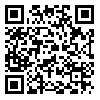Volume 2, Issue 2 (2014)
Health Educ Health Promot 2014, 2(2): 11-20 |
Back to browse issues page
Download citation:
BibTeX | RIS | EndNote | Medlars | ProCite | Reference Manager | RefWorks
Send citation to:



BibTeX | RIS | EndNote | Medlars | ProCite | Reference Manager | RefWorks
Send citation to:
Jorvand R, Amin Shokravi F, Ghazanfari Z, Sadeghi Rad K, Delshad M H. Investigating the Factors Influencing the Behavior of Health Care Workers for Needle Stick Injury (NSI). Health Educ Health Promot 2014; 2 (2) :11-20
URL: http://hehp.modares.ac.ir/article-5-11424-en.html
URL: http://hehp.modares.ac.ir/article-5-11424-en.html
Reza Jorvand1, Farkhonde Amin Shokravi *2, Zeinab Ghazanfari3, Kazemieh Sadeghi Rad4, Mohammad Hossein Delshad5
1- M.Sc. of Health Education, Department of Health Promotion, Faculty of Health, Ilam University of Medical Sciences, Ilam, Iran
2- Associate Professor, Department of Health Education & Health Promotion, Faculty of Medical Sciences, Tarbiat Modares University, Tehran, Iran
3- Associate Professor, Department of Health Promotion, Faculty of Health, Ilam University of Medical Sciences, Ilam, Iran
4- M.Sc. Student of Community Health Nursing, Department of Clinical, Health and Treatment Center of Dehloran, Ilam University of Medical Sciences, Ilam, Iran
5- Ph.D. Candidate, Department of Health Education and Health Promotion, Faculty of Medical Sciences, Tarbiat Modares University, Tehran, Iran and Expert Planning, Monitoring and Evaluation of Shahid Beheshti University of Medical Sciences and Health Services, Tehran, Iran
2- Associate Professor, Department of Health Education & Health Promotion, Faculty of Medical Sciences, Tarbiat Modares University, Tehran, Iran
3- Associate Professor, Department of Health Promotion, Faculty of Health, Ilam University of Medical Sciences, Ilam, Iran
4- M.Sc. Student of Community Health Nursing, Department of Clinical, Health and Treatment Center of Dehloran, Ilam University of Medical Sciences, Ilam, Iran
5- Ph.D. Candidate, Department of Health Education and Health Promotion, Faculty of Medical Sciences, Tarbiat Modares University, Tehran, Iran and Expert Planning, Monitoring and Evaluation of Shahid Beheshti University of Medical Sciences and Health Services, Tehran, Iran
Abstract: (5464 Views)
Aim: Injury from needle is one of the main ways of transmitting blood diseases in the medical staff. Prevention and reduction of such diseases' side effects have been emphasized by the Health Ministry. This study aimed to investigate factors influencing the behavior of the Elam city medical staff when working with sharps instruments. Methods: In a cross-sectional study, using a census method, all healthcare staff working in the health centers of Abdanan Dehloran city (total n=66) after providing written informed consent were enrolled. Data were gathered by a questionnaire. After verifying the validity and reliability, the data were collected, and analyzed using SPSS19 and descriptive statistics, Chi-square and t-test. Findings: 59% of the participants were male; 80% were married; 62% had academic educations, and 47% worked in the nursing and injection sections. The mean scores of knowledge and attitude of the participants were 3.1±1.38 and 1.7±4.1, respectively, and just 13.4% of the subjects had not reported control tests and injury events. Conclusion: Knowledge, attitudes and practices of the medical staff of injuries from sharp objects are not desirable. it seems that empowering the staff through theoretical and practical training is proper solution in this regard.
Received: 2015/04/7 | Accepted: 2014/06/1 | Published: 2015/04/28
| Rights and permissions | |
 |
This work is licensed under a Creative Commons Attribution-NonCommercial 4.0 International License. |





